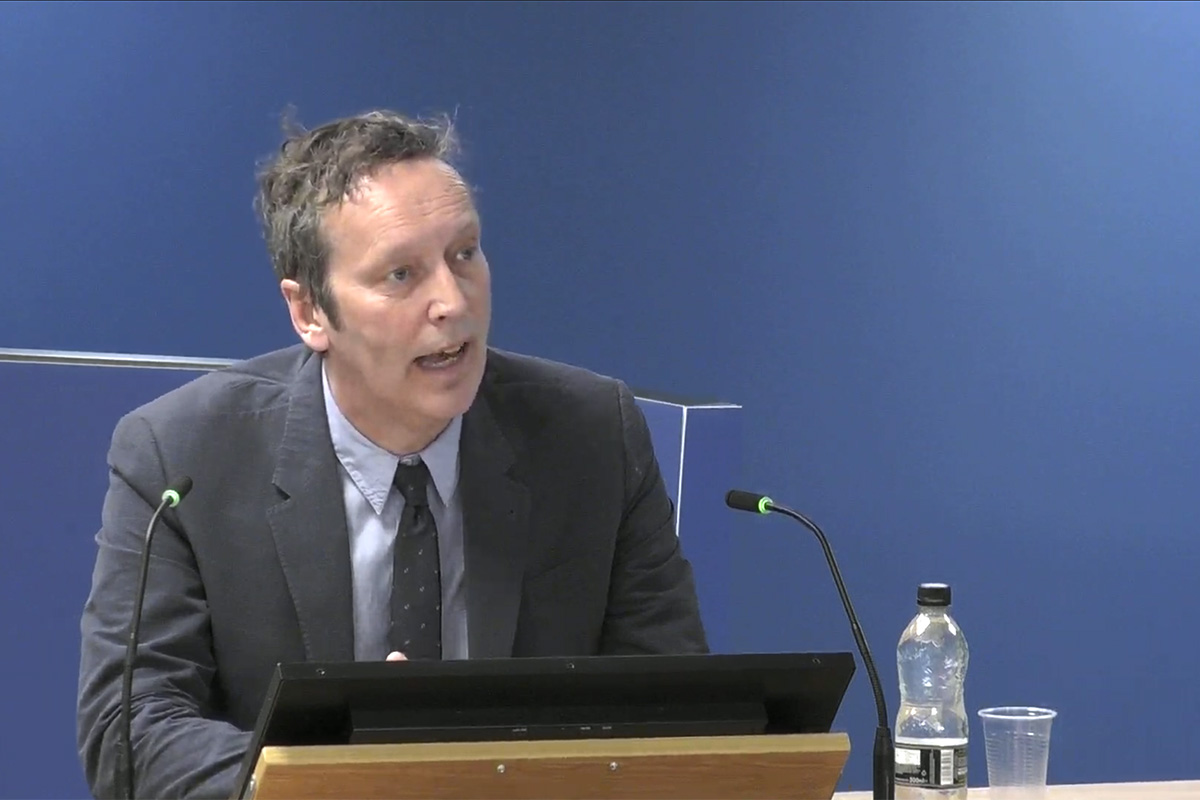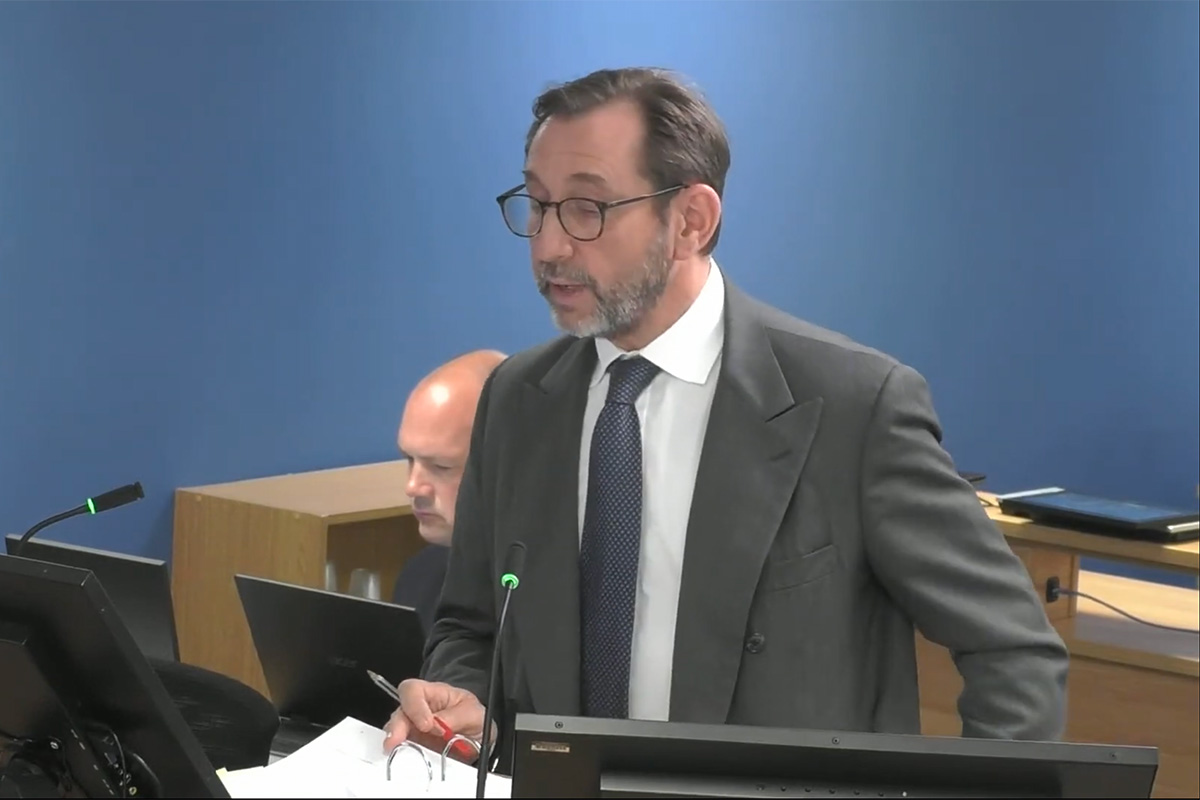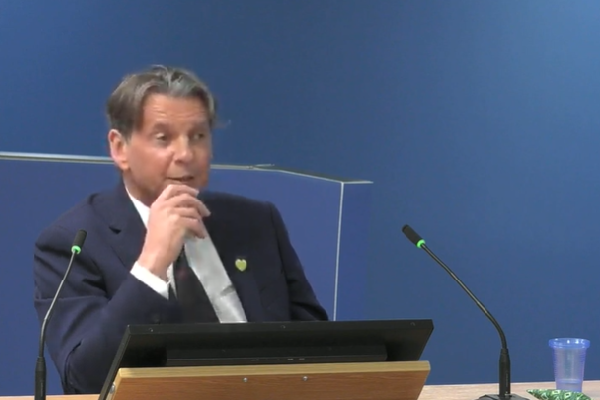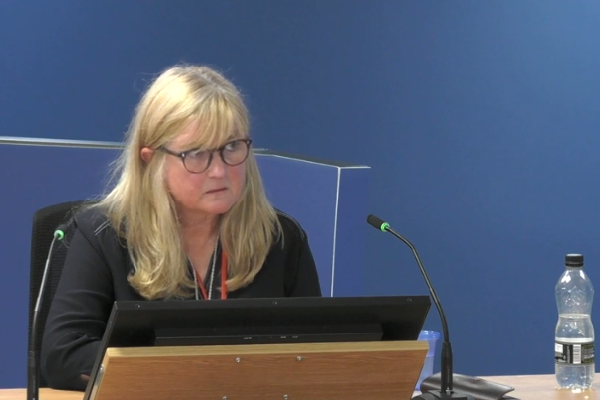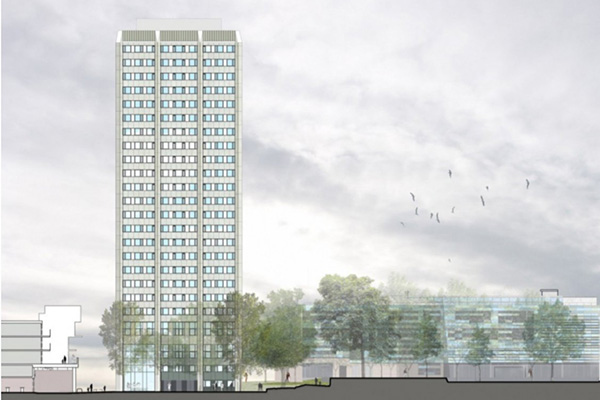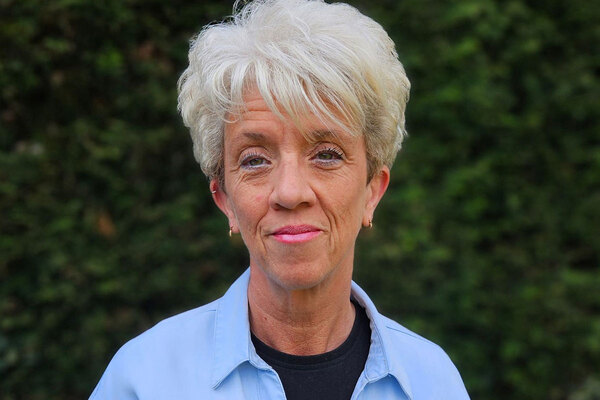Grenfell Tower Inquiry diary week 33: ‘Isn’t that a serious gap in the scope of the policy that was meant to safeguard vulnerable people?’
A slightly disjointed week at the Grenfell Tower Inquiry saw further evidence from staff at building manager Kensington and Chelsea Tenant Management Organisation (KCTMO) interspersed with the views of a cladding expert. Peter Apps reports
“There was a bit of this attitude of, ‘well, it hasn’t happened so it can’t happen’”
The inquiry returned to topics first discussed almost a year ago this week, with the evidence of Jonathan Sakula (pictured above), a cladding expert with 30 years’ experience in facades in the cladding industry.
Mr Sakula was only appointed in October and completed his report in March, hence the timing of his evidence.
He was primarily asked to explain what a “reasonably competent” cladding contractor could and should have known about the risks of using the highly combustible aluminium composite material (ACM) panels selected for Grenfell Tower.
His view, in a nutshell, was that they should have been aware it was combustible and unsafe for use on a high-rise block.
This was because of well-publicised high-rise fires, mostly in the Middle East, between 2012 to 2016 that were linked to ACM and were well known in the industry.
Mr Sakula said contractors should have known from reports of the fires that ACM was “easily ignited and combustible”.
As a result, he said using the product on a high rise was “unwise” and failing to consider the “known combustibility” would “fall below the standard expected of a reasonably competent practitioner in the cladding industry”.
He agreed with counsel to the inquiry Kate Grange QC (pictured below) when she suggested to him that the contractor should also have been aware using the product on a high rise was “unsafe”.
However, Mr Sakula said he believed the risks were not taken seriously enough by some in the industry because the fires before Grenfell did not involve severe loss of life. “It was a failure of imagination,” he said. “There was a bit of this attitude of, ‘well, it hasn’t happened so it can’t happen.’”
He also addressed some of the arguments witnesses from cladding contractor Harley Facades advanced to explain their actions.
One of these was the firm simply inherited product selections made by architect Studio E and trusted it had done the work to ensure the products were safe and compliant.
Mr Sakula’s view was that both organisations should have satisfied themselves that the products were suitable, not rely on the other to do so.
He was also asked about a certificate from the British Board of Agrément (BBA) which appeared on its front page to say the cladding met the standard of ‘Class 0’, but made clear this was actually based on quite limited testing when read in full.
Mr Sakula said the contractor was entitled to rely on the BBA certificate “to a great extent” as the BBA was a “reputable body” and its statements were “to be trusted”.
However, he felt that it should have employed “somebody with technical or design responsibility” to read the certificate “in detail to ensure that the product was appropriate for its intended use on a project”.
He also said that rather than “take comfort” from the fact that the material was widely used on many other buildings, a reasonably competent contractor should have reviewed each job on its merits because “every building is different”.
‘A cladding contractor would have interpreted this that the use of [ACM] was still allowed’
Mr Sakula also gave some important evidence on the question of what government guidance that was in force when Grenfell Tower was refurbished did and did not say.
This has been a vexed question since the fire, with the government keen to distance itself from blame by insisting the use of combustible ACM cladding was “banned” in the UK by its guidance.
This requires a little explanation. Statutory building regulations simply state that the walls of a building must “adequately resist the spread of flame”.
But the government published official guidance called ‘Approved Document B’, which sets out in detail how to comply with this standard.
This document said the “external surfaces of walls” must meet the standard of Class 0. This has been widely interpreted in the industry to apply to cladding. But Class 0 is a flawed test for fire safety, becuase it primarily assesses how the surface of a product responds to flame, and dangerous ACM products have previously obtained it.
After the fire, however, the government claimed cladding should in fact have met the higher standard of ‘limited combustibility’, which many in the industry had previously thought only applies to insulation.
Mr Sakula did not agree that this was the case. “I just think that was a bit of a stretch,” he told the inquiry.
He also reviewed various other bits of industry guidance that said cladding should meet the higher standard of ‘limited combustibility’, but said the industry would have “deferred” to the standards in Approved Document B.
“A cladding contractor would have interpreted this that the use of [ACM] was still allowed,” he wrote in his report.
None of this excuses the actions of the Grenfell Tower contractors: their use of combustible insulation put them in breach of the government guidance on any reading and Mr Sakula agreed that specific terms in their contracts would have prohibited the use of a combustible cladding product on the tower in any event.
But it leaves the government with difficult questions to answer.
Not only must it now explain why their guidance was so defective as to allow the use of dangerously combustible cladding on high rises, but also why it has spent the past four years telling us it was not.
‘Peter Maddison has suggested and I have agreed that we don’t hold any more open meetings’
Turning to the evidence of KCTMO, Peter Maddison (pictured above), director of assets at the organisation, continued his evidence this week. One of the first topics he was asked about was how KCTMO had consulted with residents about the planned refurbishment of the tower.
He was shown a KCTMO document from August 2013 that set out a plan for consultation and noted “a perception by residents that TMO doesn’t respect them”, which was driven by “inadequate and intermittent communication [which] has also given residents cause for distrust”. It said meetings regarding the project were “acrimonious and unproductive”.
Mr Maddison agreed the report was an accurate reflection of the situation at this time and said some of the bad feelings came from the delays to the refurbishment.
At the end of 2013, KCTMO took the decision to scrap public meetings regarding the refurbishment altogether and instead rely on drop-in sessions and newsletters.
Mr Maddison said this was the preference residents expressed in consultation and that the decision was made due to poor attendance at previous meetings.
But KCTMO minutes from November 2013 painted a different picture, recording that “it has been agreed to hold no more public meetings due to the stand being made by the Grenfell Tower leaseholder group”.
In his witness statement, Mr Maddison disputed this by saying it was “inaccurately recorded”.
“Why did you not correct the minutes?” asked Richard Millett QC, counsel to the inquiry.
“I don’t know that I picked up that nuance,” Mr Maddison said.
A further email from a local councillor referred to the fact that “Peter Maddison has suggested and I have agreed that we don’t hold any more open meetings” due to “disruptive” complaints being made at them by tower resident Ed Daffarn.
Asked about this email, Mr Maddison said he disagreed with it. “I felt the key issue… was that the consultation meetings weren’t effective and that we should do something different,” he said.
‘I wonder if you could advise on the point at which his comments become libellous?’
On a similar theme, Mr Maddison was also interrogated about the period when Mr Daffarn and others attempted to establish a residents group within the tower but were initially denied recognition by KCTMO.
This stretched back to January 2014 when the organisation initially told Mr Daffarn “the TMO are unable to recognise Grenfell Tower Residents Group” as there was another residents association covering the whole estate, which by this stage was barely functioning.
In April 2015, Mr Daffarn, along with neighbour David Collins, again sought recognition for the group. Once more, he was told that “this group will not be recognised” due to the existence of the other residents association.
This further refusal came just days after Mr Maddison had sent an internal email to colleagues at KCTMO complaining about the blog Mr Daffarn contributed to which raised concerns about the refurbishment.
“Mr Daffarn is continuing to agitate in Grenfell Tower,” Mr Maddison wrote. “He is clearly distributing misleading information. I wonder if you could advise on the point at which his comments become libellous?”
He attached a screen grab of a recent blog showing an early meeting of the group Mr Daffarn had established, highlighting several passages including one that said “the TMO have worked to prevent tenants and leaseholders from forming any form of collective representation”. But wasn’t this precisely what happened?
“It was certainly true, wasn’t it, that there had been past attempts by residents to gain a united voice for the Grenfell Tower community which had been refused by the TMO?” asked Mr Millett (pictured above).
Mr Maddison said he did not agree, claiming the group KCTMO had refused to acknowledge would not have been part of the refurbishment consultation.
The residents group was finally recognised in July 2015, after the intervention of the local MP.
‘I apologise, that’s a mistake in my witness statement’
Finally, Mr Maddison was grilled at length about how complaints from residents were handled by KCTMO, with reference to several specific complaints about fire safety covering the renumbering of floors in the tower and gas works carried out by the National Grid after the main refurbishment completed.
One complaint stood out, however. Mr Daffarn (pictured above) complained in August 2015 that the door of his neighbouring flat, Flat 136, was left standing open after the tenant moved out and main contractor Rydon carried out some work.
Mr Daffarn’s evidence was that the ‘self-closing’ device was holding the door ajar. We now know that many self-closing devices in Grenfell Tower had faults, which is thought to have been a major cause of the spread of smoke within communal areas on the night of the blaze.
Mr Daffarn’s complaint was not upheld by Mr Maddison, who told him the door was not broken and that Rydon’s staff were able to return and simply close the door.
This resulted in an angry response from Mr Daffarn, who felt Mr Maddison was calling him a liar.
But this week, Mr Maddison’s witness statement appeared to contradict what he had told Mr Daffarn in 2015. In his statement he said: “The door closer was repaired and an apology was given.”
Asked about this, he said: “I apologise, that’s a mistake in my witness statement… I think my solicitors have drafted that wrong.”
“I feel bound to suggest to you that when you said in your statement that the door was repaired, that was true, and that was true because it was broken earlier,” said Mr Millett.
Mr Maddison denied this, saying he had taken Rydon’s assurance that they could simply close the door “at face value”.
‘Isn’t that a serious gap in the scope of the policy that was meant to safeguard vulnerable people?’
Mr Maddison was followed by Teresa Brown (pictured above), director of housing at KCTMO, who was primarily questioned about the lack of personal emergency evacuation plans, or PEEPs, for residents of the tower.
This is a major topic for this section of the inquiry, which began with lawyers for the bereaved calling the fire “a landmark act of discrimination” against people with disabilities and noting that disabled residents of the tower died at a far higher rate than other occupants.
But it is also one that takes us into systemic, not just local, issues. KCTMO did not provide PEEPs – but neither did the vast majority of social landlords managing tower blocks around the country.
Ms Brown’s evidence gave us some insight into this. Asked why KCTMO did not develop such plans, she cited its reliance on the stay put policy and guidance published by the Local Government Association (LGA) in 2011.
This guide, commissioned by government in the aftermath of the Lakanal House fire, said preparing such documents was “usually unrealistic” and advocated reliance on stay put instead.
“We were operating according to that guidance in a way that I think other organisations across the country were,” said Ms Brown.
But lawyers for the bereaved are arguing that a statutory responsibility to provide means of escape in an emergency to all residents should not have been overridden by the guidance.
This is an awkward topic for the inquiry as one of the experts advising it on these matters is Colin Todd, a fire safety consultant who was the primary author of the LGA guide.
Ms Brown was shown a draft vulnerability policy which said the provision of PEEPs to KCTMO residents could be done in an “ad hoc and/or self-nominated” fashion.
But she accepted that this was not publicised to residents, leaving them unaware of it. The final policy made no reference to PEEPs.
“Isn’t that a serious gap in the scope of the policy that was meant to safeguard vulnerable people?” asked counsel to the inquiry Andrew Kinnear QC.
“So we weren’t looking to evacuate our residents, we were looking to utilise information in emergency situations to provide support,” Ms Brown said.
KCTMO actually had a major warning before the Grenfell tragedy of the potential need for PEEPs, when a fire at nearby Adair Tower got out of control and triggered a block-wide evacuation.
An emotional Ms Brown said data gathered by KCTMO to identify vulnerable residents was used when responding to this fire, but it did not prompt consideration of the need for evacuation plans.
“When we did a review, there was no recommendation from the LFB [London Fire Brigade] or from anybody else to have changed that,” she said.
It is worth emphasising here that the first phase of the inquiry recommended the adoption of PEEPs, but the government has so far not taken this up, after being lobbied by industry representatives who called it “totally impracticable”.
A legal challenge by bereaved families has resulted in a consultation on it being reopened but it has not yet progressed.
Grenfell Tower Inquiry: week 33 headlines
The company that managed Grenfell Tower did not prepare plans to evacuate residents with disabilities during a fire due to its reliance on government-endorsed guidance, its former director of housing has told the inquiry.
‘Competent’ contractor would have known Grenfell cladding was unsafe, says expert
A “reasonably competent” cladding contractor should have known that the combustible panels used on Grenfell were unsafe for high rises, a cladding expert told the inquiry.
A resident of Grenfell Tower who raised fire safety concerns on a blog was accused of “agitating” by a director of the building’s management company, who instructed colleagues to investigate whether the resident’s criticism could be considered “libellous”, the inquiry heard.
Grenfell Tower Inquiry phase two: weekly diaries
Module one: the refurbishment
Week one: A vivid picture of a broken industry
After a week of damning revelations at the opening of phase two of the Grenfell Tower Inquiry, Peter Apps recaps the key points
Click here to read the full story
Week two: What is the significance of the immunity application?
Sir Martin Moore-Bick has written to the attorney general requesting protection for those set to give evidence at the Grenfell Tower Inquiry. Peter Apps explains what the move means
Click here to read the full story
Week three: Architects of misfortune
This week saw the lead architects for the Grenfell Tower refurbishment give evidence to the inquiry. Peter Apps runs through the key points
Click here to read the full story
Week four: ‘I didn’t have any perception that it was the monster it’s become’
The architects continued to give evidence this week, outlining a lack of understanding of the fire risk posed by the cladding materials and its design. Nathaniel Barker reports
Click here to read the full story
Week five: ‘No adverse effect in relation to external fire spread’
As the Grenfell Tower Inquiry returns from its long absence, Peter Apps recaps the key points from a week of important evidence from the fire consultants to the refurbishment
Click here to read the full story
Week six: ‘I can’t recall any instance where I discussed the materials with building control’
Nathaniel Barker summarises what we learned from fire engineers Exova, architects Studio E and the early evidence from contractor Rydon
Click here to read the full story
Week seven: ‘I do not think I have ever worked with a contractor operating with this level of nonchalance’
Two key witnesses from contractor Rydon gave evidence this week. Peter Apps recaps some of the key points from a revealing week of evidence
Click here to read the full story
Week eight: ‘It haunts me that it wasn't challenged’
Four witnesses from contractor Rydon gave evidence this week. Lucie Heath recaps what we learned on the last week of evidence before the inquiry breaks for five weeks
Click here to read the full story
Week nine: ‘All I can say is you will be taken out for a very nice meal very soon’
This week the inquiry heard evidence from witnesses at Harley Facades, the sub-contractor responsible for Grenfell Tower’s cladding. Peter Apps recaps the key points
Click here to read the full story
Week 10: ‘As we all know, ACM will be gone rather quickly in a fire!’
As the Grenfell Tower Inquiry entered its 10th week, Jack Simpson recaps the key points from a week of important evidence from the refurbishment’s cladding contractor
Click here to read the full story
Week 11: ‘Did you get the impression Grenfell Tower was a guinea pig for this insulation?’
With witnesses from the cladding subcontractor, the firm which cut the deadly panels to shape and the clerk of works which inspected the job giving evidence this was week full of revelations. Peter Apps recaps the key points
Click here to read the full story
Week 12: ‘Would you accept that was a serious failing on your part?’
With the surveyor who inspected Grenfell Tower for compliance giving evidence, this was a crucial week from the inquiry. Dominic Brady and Peter Apps report
Click here to read the full story
Week 13: ‘Value for money is to be regarded as the key driver for this project’
With consultants to Kensington & Chelsea Tenant Management Organisation (KCTMO) giving evidence, attention at the Grenfell Tower Inquiry turned for this first time to the actions of the TMO and the council. Peter Apps reports
Click here to read the full story
Week 14: ‘Did it not occur to you at this point that your budget was simply too low?’
This week, for the first time in phase two, the inquiry heard from Kensington & Chelsea Tenant Management Organisation, the landlord that oversaw the fatal refurbishment of Grenfell Tower. Lucie Heath reports
Click here to read the full story
Week 15: ‘Have you ever informed the police that you destroyed documents relevant to their investigation?’
Witnesses from the Kensington and Chelsea Tenant Management Organisation (KCTMO) gave evidence for a second week, which began with a shocking revelation about withheld and destroyed evidence. Peter Apps recaps
Click here to read the full story
Week 16: ‘I conclude this was very serious evidence of professional negligence’
This week saw members of Kensington & Chelsea Tenant Management Organisation finish giving evidence, before the inquiry’s expert witnesses took the stand to make some highly critical assessments of the work they had seen before and during the refurbishment of Grenfell Tower. Jack Simpson recaps
Click here to read the full story
Grenfell Tower: a timeline of the refurbishment
Following the conclusion of module one of the Grenfell Inquiry’s second phase, Peter Apps presents a timeline of the key moments during the fatal refurbishment of the west London tower block
Click here to read the full story
Module two: the cladding products
Week 17: ‘It’s hard to make a note about this because we are not clean’
The start of the second module of the Grenfell Tower Inquiry phase two came with some huge revelations about the companies that sold the products used in the cladding system. Peter Apps reports
Click here to read the full story
Week 18: ‘It was just reckless optimism wasn't it?’
As the inquiry began cross-examining witnesses for the second module of its phase two work, the picture surrounding just how Grenfell Tower ended up wrapped in such dangerous materials became a little clearer. Nathaniel Barker was keeping an eye on proceedings
Click here to read the full story
Week 19: ‘And that was intentional, deliberate, dishonest?’
The Grenfell Tower Inquiry this week heard the shocking story of how the insulation manufacturer “manipulated” official testing and marketed its product “dishonestly”. Peter Apps tells the story
Click here to read the full story
Week 20: ‘We were outed by a consultant who we then had to fabricate a story to’
This week the inquiry investigated the actions of Kingspan – the manufacturer of one of the insulation products used in the tower’s cladding system. Dominic Brady reports
Click here to read the full story
Week 21: ‘It’s there in black and white isn't it? We see a complete absence of any consideration of life safety’
The story of insulation giant Kingspan’s testing and marketing of its combustible insulation for high rises was unpacked in minute detail this week. Peter Apps reports
Click here to read the full story
Week 22: ‘All we do is lie in here’
In the third week of evidence from insulation giant Kingspan, the inquiry continued to uncover shocking details about the firm’s behaviour both before and after the Grenfell Tower fire. Lucie Heath reports
Click here to read the full story
Week 23: ‘That would have come as an earthquake to you at the time, would it not?’
This week the inquiry took its deepest dive yet into the inner workings of the cladding manufacturer whose product has been blamed for the terrible spread of fire up Grenfell Tower. Nathaniel Barker reports
Click here to read the full story
Week 24: ‘Do you accept that Test 5B was Arconic's deadly secret’
The president of the firm that made and sold the cladding panels installed on Grenfell Tower was asked to account for the apparent concealment of “disastrous” fire tests on the product this week. Peter Apps reports
Click here to read the full story
Week 25: ‘This is quite an incredible list of omissions and missed instances, isn’t it?’
This week the Grenfell Tower Inquiry heard its first witnesses from the Building Research Establishment (BRE) - the testing house which carried out key fire tests on the Kingspan and Celotex insulation products which were later used on Grenfell Tower. Peter Apps reports.
Click here to read the full story
Week 26: 'You were taking an enormous risk, weren't you?'
Week 26 at the Grenfell Tower Inquiry was a key moment in understanding how dangerous products used on the tower came to be accepted by industry professionals. Dominic Brady reports
Click here to read the full story
Week 27: ‘What will happen if one building made out [of] PE core is in fire and will kill 60 to 70 persons?’
The most explosive evidence this week at the Grenfell Tower Inquiry came from those who did not attend, as the evidence which would have been presented to Arconic witnesses was displayed in their absence. Peter Apps reports
Click here to read the full story
Week 28: ‘This is a serious safety matter’
This week the Grenfell Tower Inquiry zeroed in on the British Board of Agrément, the body that produced “misleading” certificates which inspired trust in both the cladding and insulation used on the tower. Lucie Heath reports
Click here to read the full story
Week 29: ‘Is it true that Kingspan’s position… was to do its best to ensure that science was secretly perverted for financial gain?’
The final week in this section of the Grenfell Tower Inquiry primarily examined the attempts by insulation manufacturer Kingspan to lobby government after the fire. Peter Apps reports
Click here to read the full story
How the products used in Grenfell Tower's cladding system were tested and sold
As the section of the Grenfell Tower Inquiry examining how the products used in the cladding system were tested, marketed and sold comes to a close, Peter Apps summarises what we have learned about each of the products included in the system
Click here to read the full story
Module Three: the management of the tower
Week 30: ‘There is certainly a high probability that in the event of a fire the whole building can become an inferno’
The focus of the inquiry shifted this week to the actions of the social housing providers responsible for maintaining Grenfell Tower. Pete Apps recaps what we learned
Click here to read the full story
Week 31: ‘If we cannot get out people will die’
This week saw the former residents of Grenfell Tower enter the witness box to tell of their experiences attempting to raise complaints with the council and its managing agent. Pete Apps reports
Click here to read the full story
Week 32: ‘Let's hope our luck holds and there isn't a fire’
This week saw the return of the landlord of Grenfell Tower, Kensington and Chelsea Tenant Management Organisation (KCTMO), as senior staff members attempted to explain how vital fire safety protections at the block were allowed to fall into disrepair. Lucie Heath reports
Click here to read the full story
Week 33: ‘Isn't that a serious gap in the scope of a policy meant to safeguard vulnerable people?’
A slightly disjointed week at the Grenfell Tower inquiry saw further evidence from staff at building manager Kensington and Chelsea Tenant Management Organisation (KCTMO) interspersed with the views of a cladding expert. Peter Apps reports
Click here to read the full story
Week 34: ‘Some members of the community are doing their best to spread false information’
Jack Simpson covers all the major revelations from the past week of evidence at the Grenfell Inquiry, including evidence from Laura Johnson, director of housing at the Royal Borough of Kensington and Chelsea.
Click here to read the full story
Week 35: ‘I really didn’t like the champagne’
This week the Grenfell Tower Inquiry saw council witnesses, including former deputy leader Rock Feilding-Mellen and leader Nicholas Paget-Brown, questioned about their role in the story for the first time. Peter Apps reports
Click here to read the full story
Week 36: ‘Is that not a very incurious approach for a fire risk assessor?’
This week the Grenfell Tower Inquiry scrutinised the work of Carl Stokes, the man hired to carry out fire risk assessments for the block. Nathaniel Barker reports
Click here to read the full story
Week 37: ‘In giving that advice, weren’t you acting beyond your knowledge and expertise?’
A curtailed week at the Grenfell Tower Inquiry saw fire risk assessor Carl Stokes grilled over advice he gave regarding the tower’s cladding. Peter Apps reports
Click here to read the full story
Week 38: ‘Well it’s a bit more than that, isn’t it. He’s suggesting that you tell the LFB a lie’
The inquiry heard the mammoth cross-examination of KCTMO’s health and safety manager Janice Wray this week. Peter Apps reports
Click here to read the full story
Week 39: ‘What you said there was a grotesque understatement’
This week the inquiry continued to hear from former employees of Kensington and Chelsea Tenant Management Organisation, as well as two employees from the London Fire Brigade. Lucie Heath reports
Click here to read the full story
Week 40: ‘An exercise in concealment and half-truth’
Former KCTMO chief executive Robert Black gave his evidence to the inquiry this week and was asked to account for the various failures described over the previous six weeks. Peter Apps and Nathaniel Barker report.
Click here to read the full story
Week 41: ‘We should do nothing. This is not the sort of website we should be responding to’
This week saw the return of Robert Black, chief executive of Kensington and Chelsea Tenant Management Organisation (KCTMO), before the inquiry turned its attention to the defective smoke control system in the tower. Dominic Brady reports
Click here to read the full story
Week 42:‘They would leak as much as they leaked. They were what they were’
The Grenfell Tower Inquiry continued its in-depth investigation of the tower’s non-compliant smoke control system this week, with evidence from the various contractors involved in delivering it. Pete Apps reports
Click here to read the full story
Week 43:‘Contractors at the time were not generally aware of the importance of leaving holes unsealed’
This week the inquiry focused on two of the more overlooked areas of the Grenfell Tower fire, with evidence focusing on the gas pipelines and lifts within the west London block. It was a packed week, with five witnesses giving evidence. Jack Simpson reports
Click here to read the full story
Week 44:‘I've never seen a fully compliant firefighting lift in any local authority building, to this day actually’
This week the inquiry turn the focus onto the building’s defective lifts, with evidence from an expert, contractors who worked on them and a former engineer at KCTMO. Pete Apps reports.
Click here to read the full story
Week 45: ‘Don’t you find all this rather a surprising debate, given that the Equality Act was passed in 2010?’
The inquiry heard from expert witness Colin Todd this week, who gave his views about the work of risk assessor Carl Stokes as well as answered questions about his own guidance. Peter Apps and Nathaniel Barker report
Click here to read the full story
Week 46: ‘I think I've been very, very clear that is completely wrong’
This week the inquiry heard further expert evidence about fire risk assessor Carl Stokes’ actions, as the section of its work covering the management and maintenance of the tower concluded. Peter Apps reports
Click here to read the full story
Six key failures in the way Grenfell Tower was managed before the fire
Peter Apps recaps some of what we have learned about the actions of the Royal Borough of Kensington and Chelsea (RBKC) and Kensington and Chelsea Tenant Management Organisation (KCTMO) in the years before the fire.
Module one and two closing statements
Week 47: ‘An unedifying spectacle’
After a week of closing statements from the core participants involved in modules one and two, Lucie Heath recaps the key arguments of each group
Click here to read the full story
Module five: the fire brigade
Week 48: ‘They knew, and lives could and should have been saved’
The phase of the Grenfell Tower Inquiry examining the actions of the London Fire Brigade in the years before the fire kicked off this week with some major revelations. Peter Apps reports
Click here to read the full story
Week 49: ‘I'm not sure we've always taken every opportunity to learn as an organisation’
How the London Fire Brigade acted upon lessons from incidents in the years before the Grenfell Tower disaster came under the microscope this week at the public inquiry. Nathaniel Barker reports
Click here to read the full story
Week 50: ‘There is a culture in LFB that is very conservative. I think there is great comfort in what is familiar’
This week the inquiry heard how the London Fire Brigade (LFB) elected not to issue warnings about dangerous cladding before Grenfell and a detailed examination of its policy for checking high risk buildings. Pete Apps reports.
Click here to read the full story
Week 51:‘We teach firefighters to expect building failure’
An unusually brief week of evidence at the Grenfell Tower Inquiry explored how a fire service neighbouring London was taking a different approach to tackling blazes in high rises. Nathaniel Barker reports
Click here to read the full story
Week 52: ‘I actually think that there is a measure of incompetence at all levels’
Expert evidence concluded the current section of the inquiry with some stinging criticism of the London Fire Brigade (LFB). Pete Apps and Grainne Cuffe report.
Click here to read the full story
Module six: fire services
Week 53: ‘They make for chilling reading and harrowing listening’
The inquiry’s investigation into central government began this week with lawyers setting out their view on how and why firefighting policies failed. Peter Apps and Lucie Heath report
Click here to read the full story
Week 54: ‘Our consideration of evacuation at this time was something of a blind spot’
The development of policy on ‘stay put’, both nationally and for London, occupied the attention of the inquiry this week. Peter Apps reports
Click here to read the full story
Week 55: ‘My review is pretty scathing!’
In a week that included the 200th day of evidence in phase two of the inquiry, attention turned to the London Fire Brigade’s control room. Lucie Heath reports
Click here to read the full story
Week 56: ‘Why didn't we thump the table harder’
This week, the control room at the London Fire Brigade was examined further – both before and after the fire. Pete Apps and Lucie Heath report
Click here to read the full story
Week 57: ‘It was worse than slow, it was sluggish’
Former London Fire Brigade (LFB) commissioner Dany Cotton was the star witness this week, as the inquiry continued to delve into the brigade’s knowledge and training before the Grenfell Tower fire. Jack Simpson, Grainne Cuffe and Pete Apps report
Click here to read the full story
Week 58: ‘I don't think we deserve to ask for trust until we demonstrate different outcomes’
A current and former commissioner of the London Fire Brigade (LFB) wrapped up the inquiry’s investigation into the actions of the brigade before the fire. Grainne Cuffe and Peter Apps report.
Module six: testing and government
One of the major scandals of our time: key revelations as the Grenfell Tower Inquiry turns to government
The government was accused of “covering up” the risks of dangerous cladding as its “unbridled passion for deregulation” left it a “junior party” to the construction industry as the latest phase of the public inquiry opened today. Peter Apps summarises some of the main points
Click here to read the full story
Week 59: ‘Recent tests have apparently shown it continued to burn for 20 minutes after the flame was taken away’
After shocking opening statements, the Grenfell Tower Inquiry turned its attention to the work of Local Authority Building Control. Pete Apps reports
Click here to read the full story
Week 60: ‘You could have an exact repeat of the Dubai fire in any number of buildings in London’
The Grenfell Tower Inquiry turned its attention to the work of the National House Building Council this week, with shocking revelations about the extent of the warnings issued to central government before the fire. Peter Apps reports
Click here to read the full story
Week 61: ‘Mistakes are meant for learning, not repeating’
In the first hearings of the new year, the Grenfell Tower Inquiry heard closing statements from the firefighting section of phase two. Lucie Heath reports
Click here to read the full story
Week 62: Did it ever occur to you that this act of collaboration was, in one sense, corrupting?
The Grenfell Tower Inquiry returned to the work of the National House Building Council (NHBC) this week, with a new shocking revelation about the government’s actions in the immediate aftermath of the fire. Peter Apps reports
Click here to read the full story
Week 63: ‘It came after the general move to deregulation. So more regulation was not welcome’
The government’s focus on deregulation before the Grenfell Tower fire was placed in the spotlight this week with a series of shocking revelations about its failure to amend fire safety guidance. Pete Apps and Grainne Cuffe report
Click here to read the full story
Week 64: ‘I didn’t think ACM would be suitable for use in any high-rise buildings. I don’t think anyone did’
This week, the Building Research Establishment’s Dr Sarah Colwell gave more than three days of evidence, with some huge revelations about what was known about the dangers of aluminium composite material years before the fire and the mass confusion over the government’s building regulations. Peter Apps and Jack Simpson report
Click here to read the full story
Week 65: ‘Unless the government does something now about ACM panels, people will die’
Further evidence from the Building Research Establishment and the first government witnesses added new depth to our understanding of how warnings were missed before the Grenfell Tower fire. Peter Apps reports
Click here to read the full story
Week 66: ‘Was there a cover-up?’
The latest evidence from the Grenfell Tower Inquiry tracked the government’s failure to act on fire safety warnings right up until the months before the fire. Peter Apps and Grainne Cuffe report
Click here to read the full story
Week 67: ‘When exposed to a fire, the aluminium melts away and exposes the polyethylene. Whoosh!’
This week the inquiry heard disturbing new evidence about the failure of senior government officials to act on warnings about dangerous cladding in the years before the Grenfell Tower fire. Peter Apps reports
Click here to read the full story
Week 68: ‘Can we agree that was a pretty dangerous thing to have, all this falling on one man’s shoulders?’
Three senior civil servants gave evidence this week, including the official who had responsibility for building regulations guidance on fire safety in the years before Grenfell. Peter Apps, Lucie Heath, Stephen Delahunty and Grainne Cuffe report
Click here to read the full story
Week 69: ‘It was just unthinkable. You had the makings here of a crisis you could not comprehend’
This week, civil servant Brian Martin gave his long-awaited evidence to the Grenfell Tower Inquiry. Peter Apps reports
Click here to read the full story
Week 70: ‘Show me the bodies’
An important week at the Grenfell Tower Inquiry saw a dramatic conclusion to the mammoth cross-examination of civil servant Brian Martin, as well as the first politicians. Peter Apps and Lucie Heath report
Click here to read the full story
Week 71: ‘I have changed my schedule to fit this in. I do have an extremely busy day meeting people’
Three politicians who were responsible for building regulations before Grenfell appeared before the inquiry this week, including the former communities secretary Eric Pickles, who responded to the coroner’s letter following the Lakanal House fire. Peter Apps and Lucie Heath report
Click here to read the full story
Module Four: aftermath
Week 72: 'The system isn't broken. It was built this way'
This week the inquiry turned to the shocking story of the lack of support for bereaved and survivors in the immediate aftermath of the Grenfell Tower fire. Peter Apps, Lucie Heath, Grainne Cuffe and Jack Simpson report
Click here to read the full story
Week 73: ‘Most people would regard that as hopeless’
This week, the Grenfell Tower Inquiry heard about the Royal Borough of Kensington and Chelsea’s chaotic response in the immediate aftermath of the blaze, from the staff responsible for it. Pete Apps, Stephen Delahunty and Grainne Cuffe report
Click here to read the full story
Week 74: ‘Do you agree that RBKC was ill-prepared and incapable to meet its duties’
This week, Nicholas Holgate, former chief executive of the Royal Borough of Kensington and Chelsea, was grilled on his failure to hand over control of the aftermath of the fire, despite the borough’s lack of capacity. Peter Apps reports
Click here to read the full story
Week 75: ‘It still shocks me to the core that that’s how we treat our citizens in this country’
This week the inquiry heard witnesses from the housing management body discuss their role in the aftermath of the Grenfell Tower fire, followed by a range of witnesses from other organisations which supported the response. Peter Apps and Grainne Cuffe report
Click here to read the full story
Week 76: ‘I fear this will become our New Orleans’
This week the inquiry heard from central government figures and members of the London-wide emergency response arrangements. Peter Apps and Grainne Cuffe report
Click here to read the full story
Week 77: ‘The planning wasn’t done and there was nothing for us to be drawing on’
The Grenfell Tower Inquiry’s examination of the aftermath of the fire concluded with witnesses from central government. Peter Apps reports
Click here to read the full story
Module seven: expert evidence and closing statements
Week 78: ‘The abandonment of the ‘stay put’ strategy for high-rise residential buildings is essential’
This week the Grenfell Tower Inquiry heard a range of expert witnesses discuss their reports. Peter Apps and Grainne Cuffe report
Click here to read the full story
Week 79: ‘You could argue the system was created to enable people to circumvent the rules’
The Grenfell Tower Inquiry continued to hear expert evidence this week, with two senior figures in the world of fire safety academia criticising the government’s approach before and after the blaze. Peter Apps and Grainne Cuffe report
Click here to read the full story
Week 80: ‘The evidence points to wilful blindness and complacency towards safety’
As the inquiry moves into its final stages, lawyers for the key players gave statements about the evidence surrounding central government. Peter Apps reports
Click here to read the full story
Week 81: ‘This is Islamophobia. It’s racism. It is the elephant staring back at us in the room’
This week, closing statements covering the aftermath of the fire delivered a shocking new revelation and an expert toxicologist gave his views on the causes of the deaths. Peter Apps reports
Click here to read the full story
Module eight: further evidence relating to the deceased
Week 82: ‘Their chance to hear about the circumstances in which their loved ones died is the culmination of five years of waiting’
The Grenfell Tower Inquiry moved into its final module this week, with evidence relating to the circumstances in which the victims died. Peter Apps reports
Click here to read the full story
Week 83: ‘They died together as they lived: caring for one another’
A second week of evidence relating to the circumstances in which the victims of the fire died delivered more heartbreaking stories about their final moments. Peter Apps recaps
Click here to read the full story
Week 84: ‘Every decision affects someone who is an adored child, a beloved sister, a respected uncle, a needed mother’
The final week of oral evidence for the Grenfell Tower Inquiry’s second phase contained more heartbreaking evidence about the deaths in the tower. Peter Apps reports
Click here to read the full story
Closing statements
Week 85: ‘The merry-go-round turns still, the notes of its melody clearly audible in the last few days’
The Grenfell Tower Inquiry returned this week for closing statements from lawyers representing the bereaved and survivors and the various parties under scrutiny for the fire. Pete Apps reports.

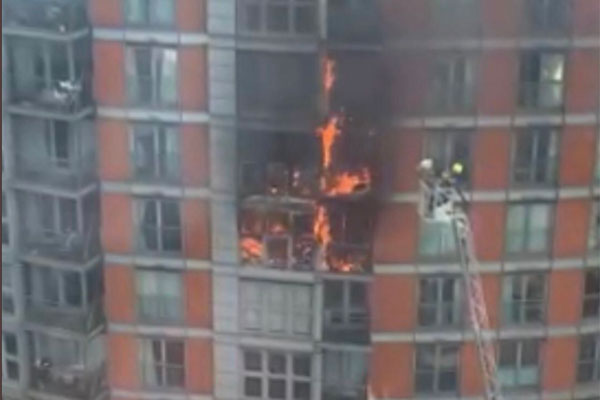
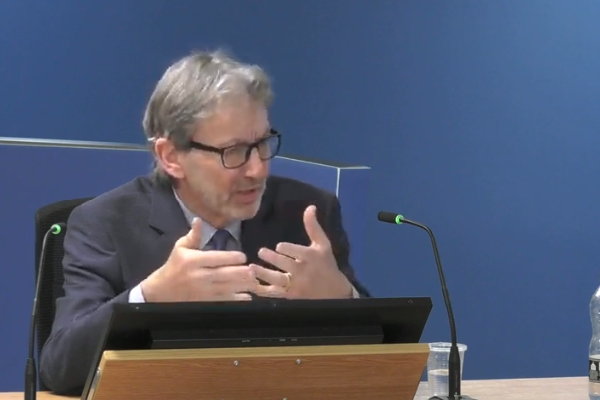
![‘A cladding contractor would have interpreted this that the use of [ACM] was still allowed’ ‘A cladding contractor would have interpreted this that the use of [ACM] was still allowed’](https://omghcontent.affino.com/AcuCustom/Sitename/DAM/146/grange__thumb.png)
